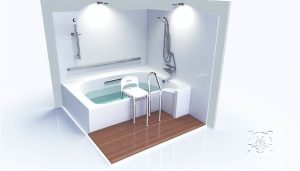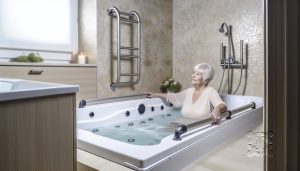Enhancing Safety and Accessibility With Walk-In Tubs
In recent years, the advent of walk-in tubs has signaled a significant shift in the approach to safe and accessible bathing solutions for individuals with limited mobility or those seeking enhanced comfort within their personal care routines. Designed with a low threshold entry, integrated safety features, and options for wheelchair accessibility, these innovative fixtures are increasingly recognized for their role in fostering independence and dignity in the bathroom—a sanctuary that can present considerable challenges for safety and accessibility.
As we examine the nuanced implications of integrating walk-in tubs into home and healthcare environments, one must consider not only the immediate ergonomic benefits but also the potential long-term impact on users’ quality of life. The discussion that unfolds will illuminate the intersection where functionality meets wellness, revealing how such installations can transcend mere convenience to become a cornerstone of therapeutic relief and autonomy in daily living.
Low Threshold Entry
 One of the fundamental features of walk-in tubs that significantly reduces the risk of falls is their low threshold entry, designed to allow easy and safe access for users of all mobility levels. This innovative aspect not only prioritizes slip prevention but also seamlessly integrates with the overall design aesthetics of the bathroom. The low threshold minimizes the effort required to step in and out of the tub, effectively eliminating the high ledge that is a common tripping hazard in traditional bathtub designs.
One of the fundamental features of walk-in tubs that significantly reduces the risk of falls is their low threshold entry, designed to allow easy and safe access for users of all mobility levels. This innovative aspect not only prioritizes slip prevention but also seamlessly integrates with the overall design aesthetics of the bathroom. The low threshold minimizes the effort required to step in and out of the tub, effectively eliminating the high ledge that is a common tripping hazard in traditional bathtub designs.
Manufacturers of walk-in tubs have meticulously engineered these bathing solutions to cater to both safety concerns and the desire for an elegant bathroom. The strategic balance between functionality and style ensures that the inclusion of a walk-in tub enhances the user experience without compromising the visual appeal of the space. The design aesthetics are carefully considered, with a range of finishes and materials available to complement the existing decor while incorporating essential safety features such as textured floors and built-in handrails for additional slip prevention.
The integration of low threshold entry in walk-in tubs exemplifies a commitment to accessibility and safety, ensuring that individuals can maintain independence in their bathing routines with confidence and dignity.
Built-In Safety Features
Walk-in tubs come equipped with a variety of built-in safety features designed to provide users with stability, comfort, and peace of mind during their bathing experience. These specialized tubs often include a slip-resistant texture on the floor and seat surfaces to mitigate the risk of falls, which are all too common in standard tubs and showers. This thoughtful detail ensures a firmer footing, even when surfaces are wet and soapy.
In addition to the textured surfaces, grab bar installation is a standard safety measure in these tubs. Strategically placed, these bars offer support and leverage for individuals as they enter and exit the tub, or when they need to shift positions while bathing. The grab bars are typically installed within easy reach and are designed to support a substantial amount of weight, providing an extra layer of security.
Moreover, walk-in tubs often have controls that are easy to reach and operate, anti-scald valves to prevent burns from hot water, and built-in seats that allow users to bathe comfortably without lowering themselves to the floor of the tub. Collectively, these safety features create a bathing environment that prioritizes the well-being and independence of users, particularly those with mobility challenges.
Wheelchair Accessibility Options
Building upon the foundational safety features, many walk-in tubs also offer wheelchair accessibility options to accommodate users who require seamless transfer from a mobility device to the bath. Wheelchair-accessible walk-in tubs are designed with an emphasis on independence, allowing individuals with mobility impairments to enjoy a bath without assistance. The thoughtful integration of these features underscores a commitment to inclusivity and user autonomy.
Wheelchair accessibility features may include:
- Lowered step-in threshold:
- Facilitates easy entry and exit for wheelchair users.
- Reduces the risk of tripping and falling.
- Outward swinging doors:
- Enables direct lateral transfers from a wheelchair.
- Provides ample space for maneuvering.
- Swivel seats and grab bars:
- Swivel seats allow users to pivot and position themselves comfortably.
- Strategically placed grab bars offer stability and support during transfers.
These enhancements not only expand the user base for walk-in tubs but also contribute to a safer bathing experience. The combination of swivel seats and grab bars, in particular, can significantly reduce the physical strain associated with getting in and out of the tub, thereby promoting a sense of dignity and self-reliance among users with limited mobility.
Customizable Comfort Controls
To further enhance the user experience, walk-in tubs often feature customizable comfort controls that allow individuals to tailor their bathing environment to their personal preferences. These advanced features provide users with the ability to set temperature presets, ensuring that each bath is at an ideal and consistent warmth, suited to personal comfort levels and health requirements. The ability to adjust the jet intensity is another key aspect, allowing users to select a gentle flow for relaxation or a more vigorous stream for therapeutic massage effects.
Customizable options not only offer a personalized bathing experience but also contribute to safety by preventing scalding and reducing the risks associated with high-pressure water streams. Below is a table detailing some of the customizable features available in walk-in tubs:
| Feature | Description | Benefit |
|---|---|---|
| Temperature Presets | Set and save preferred water temperatures. | Consistency and safety in water temperature. |
| Jet Intensity | Adjust the strength of water jets. | Tailored hydrotherapy and comfort levels. |
| Chromotherapy | Selectable lighting colors for mood enhancement. | Aids in relaxation and therapeutic ambiance. |
Therapeutic Benefits
 Beyond personal comfort, the adjustable features of walk-in tubs also contribute to various therapeutic benefits, including pain relief and improved circulation. Users can experience significant improvements in their physical well-being, thanks to the integration of advanced technologies and therapeutic systems. These systems not only enhance the bathing experience but also offer health benefits that can alleviate various conditions.
Beyond personal comfort, the adjustable features of walk-in tubs also contribute to various therapeutic benefits, including pain relief and improved circulation. Users can experience significant improvements in their physical well-being, thanks to the integration of advanced technologies and therapeutic systems. These systems not only enhance the bathing experience but also offer health benefits that can alleviate various conditions.
Hydrotherapy Relief
- Arthritis and Joint Pain: The warm water and massage jets can soothe stiff joints and reduce arthritic pain.
- Muscle Relaxation: Targeted streams of water promote relaxation of tense muscles, aiding in recovery from strains or fatigue.
- Stress Reduction: The calming effect of water can lower stress levels, contributing to overall mental health.
Aromatherapy Options
- Mood Enhancement: Scents like lavender or eucalyptus can uplift the mood and create a spa-like atmosphere.
- Respiratory Support: Certain aromas can help clear respiratory pathways, beneficial for individuals with sinus issues.
- Sleep Improvement: A relaxing soak with calming fragrances can lead to better sleep quality.
Additional Benefits
- Skin Care: Warm water can open pores and cleanse the skin, while certain bath oils and salts can nourish and rejuvenate.
- Circulatory Support: Improved circulation from hydrotherapeutic features can aid in healing and cell regeneration.
- Accessibility: Those with mobility challenges can independently enjoy the therapeutic aspects without assistance.
Walk-in tubs provide a multifaceted approach to wellness, combining safety, comfort, and therapeutic efficacy to enhance the quality of daily living.
Conclusion
In conclusion, walk-in tubs offer a harmonious blend of safety and luxury, serving as a lighthouse guiding individuals through the rough seas of mobility challenges toward the shores of independence.
These tubs, equipped with low thresholds, safety features, and wheelchair accessibility, provide a sanctuary of comfort with customizable controls and therapeutic advantages.
They stand as a testament to the advancements in home healthcare, ensuring a dignified and secure bathing experience for all users.
